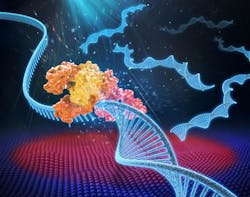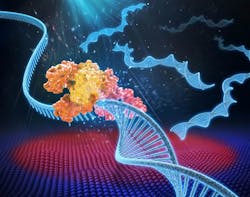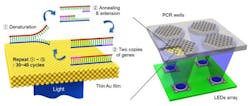LEDs enable ultrafast thermal cycling for cheaper DNA diagnostics
University of California–Berkeley bioengineers used light-emitting diodes (LEDs) to help accelerate the heating and cooling of genetic samples. This turbocharged thermal cycling greatly expands the clinical and research applications of the polymerase chain reaction (PCR) test, with results ready in minutes instead of an hour or more.
Related: Advances in optical biodetection
The PCR test, which amplifies a single copy of a DNA sequence to produce thousands to millions of copies, has become vital in genomics applications, ranging from cloning research to forensic analysis to paternity tests. PCR is used in the early diagnosis of hereditary and infectious diseases, and for analysis of ancient DNA samples of mummies and mammoths.
Using LEDs, the researchers were able to heat electrons at the interface of thin films of gold and a DNA solution. They clocked the speed of heating the solution at around 55°F/s. The rate of cooling was equally impressive, coming in at about 43.9°F/s.
The slowdown in conventional PCR tests comes from the time it takes to heat and cool the DNA solution. The PCR test requires repeated temperature changes—an average of 30 thermal cycles at three different temperatures—to amplify the genetic sequence, a process that involves breaking up the double-stranded DNA and binding the single strand with a matching primer. With each heating-cooling cycle, the amount of the DNA sample is doubled.
To pick up the pace of this thermal cycling, study senior author Luke Lee, a professor of bioengineering, and his team of researchers took advantage of plasmonics, or the interaction between light and free electrons on a metal’s surface. When exposed to light, the free electrons get excited and begin to oscillate, generating heat. Once the light is off, the oscillations and the heating stop.
For their experiments, the researchers used thin films of gold that were 120 nm thick, or about the width of a rabies virus. The gold was deposited onto a plastic chip with microfluidic wells to hold the PCR mixture with the DNA sample. The light source was an array of off-the-shelf LEDs positioned beneath the PCR wells. The peak wavelength of the blue LED light was 450 nm, tuned to get the most efficient light-to-heat conversion. The researchers were able to cycle from 131° to 203°F 30 times in less than five minutes.
They tested the ability of the photonic PCR system to amplify a sample of DNA, and found that the results compared well with conventional PCR tests.
“This photonic PCR system is fast, sensitive and low-cost,” says Lee, who is also co-director of the Berkeley Sensor and Actuator Center. “It can be integrated into an ultrafast genomic diagnostic chip, which we are developing for practical use in the field. Because this technology yields point-of-care results, we can use this in a wide range of settings, from rural Africa to a hospital ER.”
Full details of the work appear in the journal Light: Science & Applications; for more information, please visit http://dx.doi.org/10.1038/lsa.2015.53.
Follow us on Twitter, 'like' us on Facebook, connect with us on Google+, and join our group on LinkedIn


